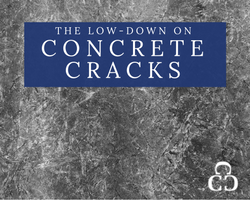
Just as sure as concrete will harden, it will crack. Although concrete is known to be one of the most durable building materials in the world, it is still susceptible to cracking. While this is true, it does not make concrete any less of a solid investment for your commercial or home flooring purposes. So that you’re better informed on this issue, we’ve provided some insight below to let you know why concrete cracks, how to prevent cracks, and just what type of cracks are acceptable and which are not.
Why Does Concrete Crack?
Cracking can be caused by one or a number of combined factors including settlement within a concrete mass, plastic shrinkage, drying shrinkage, and thermal contraction to name a few. Below we’ll discuss each more in-depth to give you a better understanding of why exactly cracking occurs.
Reason #1: Settlement Within The Concrete Mass
Settlement cracks within a concrete mass often occur around embedded items such as steel or when wet, drying concrete comes into contact with already hardened forms of concrete. These cracks develop as a result of insufficient consolidation (vibration), high slumps (overly wet concrete), or a lack of adequate cover over embedded items.
Reason #2: Plastic Shrinkage
Plastic shrinkage occurs when surface moisture is evaporated faster than it can be replaced. As a result, the surface concrete shrinks faster than the interior, and because the interior concrete must restrain shrinkage of the interior concrete, stresses occur that may exceed the concrete's strength, resulting in surface cracks.
Reason #3: Drying Shrinkage
Many of the cracks reported after drying can be attributed to drying shrinkage. While concrete is in the process of drying, it can be expected to shrink 1/16 in. in 10 ft. of length. The major factor affecting this process is the amount of water in the concrete mix. As the amount of water increases, so does the amount of shrinkage. Reductions in the size of coarse aggregates and increases in the sand content aid in shrinking because total water is increased. Also, because smaller coarse aggregates provide less of an internal restraint to shrinkage. High-shrinkage aggregates and calcium chloride admixtures also add to the process of drying shrinkage.
Reason #4: Thermal Contraction (Or Expansion)
Due to the laws of nature, temperatures are usually higher during the day and lower at night, so when concrete is poured in the middle of a hot day, it should be expected to contract some at night. Temperature drops like this are common, especially in areas such as Omaha, so this should always be taken into account when concrete is poured.
How Can You Prevent Cracking?
Although one can not completely prevent cracking within concrete, as it is a natural phenomenon with this product, there are some preventative steps that can be taken to significantly reduce its occurrence. Here are 7 provided by the Concrete Foundations Association:
- Minimize the mix water content by maximizing the size and amount of coarse aggregate and by using low-shrinkage aggregate.
- Use the lowest amount of mix water required for workability and placement; do not permit overly wet consistencies.
- Use calcium chloride admixtures only when necessary.
- Prevent rapid loss of surface moisture while the concrete is still plastic through use of spray-applied finishing aids or plastic sheets to avoid plastic-shrinkage cracks (more important in slabs).
- Provide contraction joints at reasonable intervals, 30 times the wall thickness is a good “rule-of-thumb.”
- Prevent extreme changes in temperature after placement and initial cure.
- Properly place and consolidate the concrete.
Again, it’s important to remember though that while concrete cracking cannot be prevented entirely, it can be significantly reduced if the given preventive steps are taken into account.
What Is The Acceptable Width For Concrete Cracks?
As discussed, cracks are going to occur no matter what. While most of the time they are just aesthetically displeasing, it is important to know when they become a safety issue. While this answer will vary depending on who you ask, the general accepted range is between 1/16” and 1/4” wide. Cracks within this range generally don’t affect the function of the mass, but anything greater shouldn’t be ignored.
To learn more about concrete and concrete cracks, click here. To learn how to fix other issues with problem floors, click here.
At Custom Concrete Creations, we have state of the art equipment and a properly trained team with years of experience. Custom Concrete Creations is a premier contractor serving the Omaha area as well at the Midwest. Give us a call or send us an email for your custom concrete finishing needs today!
